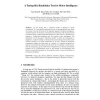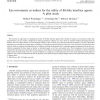619 search results - page 29 / 124 » Human identification from human movements |
BSN
2009
IEEE
14 years 3 months ago
2009
IEEE
—Human movement models often divide movements into parts. In walking the stride can be segmented into four different parts, and in golf and other sports, the swing is divided int...
CVPR
2006
IEEE
14 years 10 months ago
2006
IEEE
Dynamic appearance is one of the most important cues for tracking and identifying moving people. However, direct modeling spatio-temporal variations of such appearance is often a ...
HAPTICS
2010
IEEE
14 years 1 months ago
2010
IEEE
In the Turing test, a computer model is deemed to “think intelligently” if it can generate answers that are not distinguishable from those of a human. This test is limited to t...
TSMC
2008
13 years 8 months ago
2008
Recent studies have shown that the perception of natural movements--in the sense of being "humanlike"--depends on both joint and task space characteristics of the movemen...
IWC
2007
13 years 8 months ago
2007
We motivate an approach to evaluating the utility of life-like interface agents that is based on human eye movements rather than questionnaires. An eye tracker is employed to obta...


